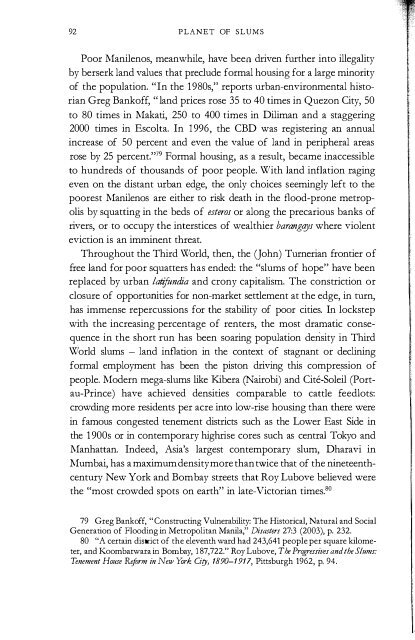Untitled - Rebel Studies Library
Untitled - Rebel Studies Library
Untitled - Rebel Studies Library
Create successful ePaper yourself
Turn your PDF publications into a flip-book with our unique Google optimized e-Paper software.
92 PLANET OF SLUMS<br />
Poor Manilenos, meanwhile, have been driven further into illegality<br />
by berserk land values that preclude formal housing for a large minority<br />
of the population. "In the 1980s," reports urban-environmental historian<br />
Greg Bankoff, "land prices rose 35 to 40 times in Quezon City, 50<br />
to 80 times in Makati, 250 to 400 times in Diliman and a staggering<br />
2000 times in Escolta. In 1996, the CBD was registering an annual<br />
increase of 50 percent and even the value of land in peripheral areas<br />
rose by 25 percent."79 Formal housing, as a result, became inaccessible<br />
to hundreds of thousands of poor people. With land inflation raging<br />
even on the distant urban edge, the only choices seemingly left to the<br />
poorest Manilenos are either to risk death in the flood-prone metropolis<br />
by squatting in the beds of esteros or along the precarious banks of<br />
rivers, or to occupy the interstices of wealthier barangqys where violent<br />
eviction is an imminent threat.<br />
Throughout the Third World, then, the (John) Turnerian frontier of<br />
free land for poor squatters has ended: the "slums of hope" have been<br />
replaced by urban /atifundia and crony capitalism. The constriction or<br />
closure of opportunities for non-market settlement at the edge, in turn,<br />
has immense repercussions for the stability of poor cities. In lockstep<br />
with the increasing percentage of renters, the most dramatic consequence<br />
in the short run has been soaring population density in Third<br />
World slums - land inflation in the context of stagnant or declining<br />
formal employment has been the piston driving this compression of<br />
people. Modern mega-slums like Kibera (Nairobi) and Cite-Soleil (Portau-Prince)<br />
have achieved densities comparable to cattle feedlots:<br />
crowding more residents per acre into low-rise housing than there were<br />
in famous congested tenement districts such as the Lower East Side in<br />
the 1900s or in contemporary highrise cores such as central Tokyo and<br />
Manhattan. Indeed, Asia's largest contemporary slum, Dharavi in<br />
Mumbai, has a maximum density more than twice that of the nineteenthcentury<br />
New York and Bombay streets that Roy Lubove believed were<br />
the "most crowded spots on earth" in late-Victorian times.80<br />
79 Greg Bankoff, "Constructing Vulnerability: The Historical, Natural and Social<br />
Generation of Flooding in Metropolitan Manila," Disasters 27:3 (2003), p. 232.<br />
80 "A certain disllrict of the eleventh ward had 243,641 people per square kilometer,<br />
and Koombarwara in Born bay, 187,722." Roy Lubove, The Progressives and t he Slums:<br />
Tenement House Reform in New York City, 1890-1917, Pittsburgh 1962, p. 94.<br />
ILLUSIONS OF SELF-HELP 93<br />
This urban population implosion via relentless infill and overcrowding<br />
almost defies credulity. In Kolkata's bustees, for example, an average<br />
of 13.4 people are somehow shoehorned into each occupied room. If<br />
municipal statistics can be believed, Dharavi compacts an incredible<br />
18,000 people per acre into 1O-by-15-foot rooms stacked on top of one<br />
another.81 Manshiyet Nasr, at the foot of the Muqattam Hills east of<br />
the Nile, is only slightly less congested: more than one-half million<br />
people share a mere 350 hectares. (At its southern edge, "in conditions<br />
of Dantesque degradation" according to the Financia/ Times, the<br />
famous Zaballeen pick through rubbish for their subsistence.)82 Rio's<br />
fave/as, meanwhile, are being rapidly Manhattanized in response to a<br />
lack of squattable land and thus a burgeoning demand for rental rooms.<br />
"We can see side by side with the peripheralization of Rio fave/as,"<br />
writes Suzan a Taschner, "a verticalization of the oldest ones, where<br />
buildings with four to six stories appear, often for rent."83<br />
Thanks to the commercialization of edge development, densification<br />
has become almost as ubiquitous on the periphery as in the urban<br />
core. In Caracas, for example, banios are densifying at the rate of<br />
almost 2 percent per year: much of this is vertical growth up the mountainsides.<br />
Columbia University scientists, researching the city's landslide<br />
hazard, were amazed by the mountaineering challenge of being poor in<br />
the Venezuelan metropolis. "Indeed some residents are required to<br />
climb up the equivalent of 25 stories to reach their rancho houses and<br />
the average banio dweller needs almost 30 minutes on foot to reach<br />
public transportation."84 In Bogota the southward expansion of the<br />
zone of poverty has preserved high density despite increasing household<br />
size toward the periphery.8 s<br />
Lagos's greatest slum, Ajegunle, exemplifies the worst of worlds:<br />
overcrowding coupled with extreme peripherality. In 1972, Ajegunle<br />
contained 90,000 people on 8 square kilometers of swampy land; today<br />
1.5 million people reside on an only slightly larger surface area, and<br />
81 Sharma, Rediscoveling Dharmi, pp. xx, xxvii, 18.<br />
82 James Drummond, "Providing Collateral for a Better Future," Financial Times,<br />
18 October 2001.<br />
83 Suzana Taschner, "Squatter Settlements and Slums in Brazil," pp. 196, 219.<br />
84 Urban Planning Studio, Disaster Resistant Caracas, p. 27.<br />
85 Mohan, Understanding the Develojing Metropolis, p. 55.


